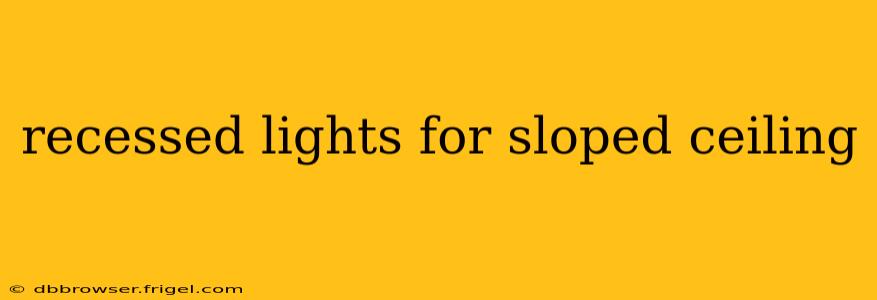Installing recessed lighting in a sloped ceiling presents unique challenges, but the results—a beautifully illuminated space—are well worth the effort. This guide will cover everything you need to know to successfully install recessed lights in your sloped ceiling, from choosing the right fixtures to understanding the installation process. We'll even address some frequently asked questions to ensure you're fully prepared.
What are the best types of recessed lights for sloped ceilings?
Several options exist for recessed lighting in sloped ceilings, each with its advantages and disadvantages. The most common types include:
-
IC-rated (Insulation Contact) recessed lights: These are designed to be installed in contact with insulation, making them safer and easier to install in sloped ceilings where insulation is often present. This is a crucial safety feature to prevent overheating.
-
Non-IC-rated recessed lights: These should never be installed in contact with insulation. While sometimes cheaper, the safety risk outweighs any cost savings in most sloped ceiling applications.
-
Adjustable recessed lights: These lights allow you to tilt the light fixture, enabling you to direct the light exactly where you need it, particularly useful on sloped ceilings to avoid harsh shadows or direct light in unwanted areas.
-
Specialty sloped ceiling fixtures: Some manufacturers produce recessed lights specifically designed for sloped ceilings. These often incorporate features like integrated baffles or heat sinks to address the challenges posed by the unique installation.
How to install recessed lights in a sloped ceiling?
The process of installing recessed lights in a sloped ceiling is more complex than in a flat ceiling, requiring careful planning and precise execution. Here’s a general overview:
-
Planning and Measurement: Accurately measure the location of your joists and plan the placement of your lights to avoid obstructions. Consider the light distribution and ensure adequate spacing for even illumination.
-
Cutting the Hole: Use a hole saw specifically designed for cutting the appropriate size hole in your sloped ceiling. Be precise to avoid damaging surrounding materials.
-
Wiring: Carefully connect the wiring to your recessed light fixture, ensuring proper grounding and insulation. Consult a qualified electrician if you are not comfortable with electrical work.
-
Insulation Management: If using IC-rated fixtures, ensure they are properly installed and that insulation does not impede airflow. For non-IC rated fixtures, ensure adequate clearance from insulation to prevent overheating.
-
Fixture Installation: Securely mount the recessed light fixture within the cut-out, paying close attention to the manufacturer's instructions. Use appropriate fasteners and ensure a snug fit.
What size hole do I need to cut for recessed lighting in a sloped ceiling?
The size of the hole you need to cut depends entirely on the size of the recessed light fixture you've chosen. Always refer to the manufacturer’s instructions for precise hole size specifications. Using the wrong size hole saw can damage the fixture or compromise the installation.
How far apart should recessed lights be on a sloped ceiling?
The optimal spacing between recessed lights on a sloped ceiling depends on several factors: the room's size, the light output of the fixtures, and the desired level of illumination. A general guideline is to space them 2-4 feet apart for even coverage, but it’s best to consult an illumination guide or lighting professional for a tailored recommendation.
Can I install recessed lighting in a sloped ceiling myself?
While some DIYers may be comfortable tackling this project, installing recessed lights in a sloped ceiling involves working with electricity and potentially challenging angles. If you're unsure about any aspect of the electrical work or feel uncomfortable working at heights, it's best to hire a qualified electrician to ensure a safe and properly functioning installation. Remember, safety should always be your top priority.
Are there any special considerations for installing recessed lighting in a sloped ceiling?
Yes, several factors require special consideration:
- Accessibility: Reaching the installation point in a sloped ceiling can be challenging. You may need a ladder or scaffolding for safe access.
- Insulation: Proper insulation management is crucial to prevent overheating and fire hazards. Use IC-rated fixtures whenever possible.
- Angle of the slope: The angle of the slope will affect the light distribution, so adjustable fixtures may be necessary to optimize illumination.
- Structural considerations: Ensure that you are not cutting into any structural members of the ceiling.
By carefully considering these factors and following the proper installation techniques, you can successfully install recessed lighting in your sloped ceiling and enjoy the beautiful, even illumination it provides. Remember to always prioritize safety and consult a professional if you are unsure about any aspect of the installation.
